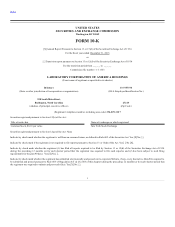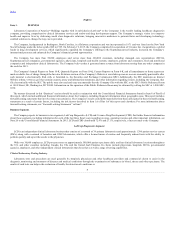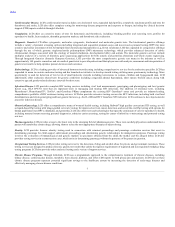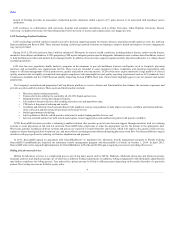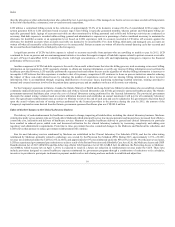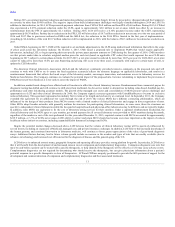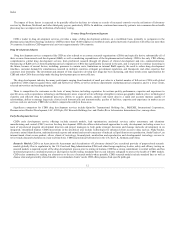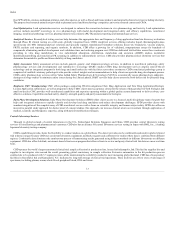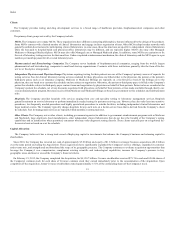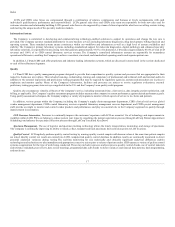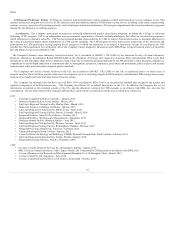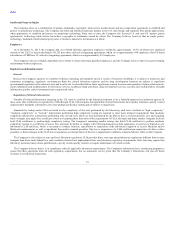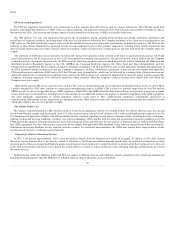LabCorp 2015 Annual Report Download - page 10
Download and view the complete annual report
Please find page 10 of the 2015 LabCorp annual report below. You can navigate through the pages in the report by either clicking on the pages listed below, or by using the keyword search tool below to find specific information within the annual report.
Index
than the physician or other authorized person who ordered the test. A growing portion of the managed care fee-for-service revenues are derived from patients
in the form of deductibles, coinsurance, non-covered tests and copayments.
LCD utilizes a centralized billing system in the collection of approximately 93.6% of its domestic revenue (88.4% of consolidated LCD revenue). This
system generates bills to LCD customers based on payer type. Client billing is typically generated monthly, whereas patient and third-party billing are
typically generated daily. Agings of accounts receivable are then monitored by billing personnel and re-bills and follow-up activities are conducted as
necessary. Bad debt expense is recorded within selling, general and administrative expenses as a percentage of sales considered necessary to maintain the
allowance for doubtful accounts at an appropriate level, based on LCD's experience with its accounts receivable. LCD writes off accounts against the
allowance for doubtful accounts when accounts receivable are deemed to be uncollectible. For client billing, third party and managed care, accounts are
written off when all reasonable collection efforts prove to be unsuccessful. Patient accounts are written off after the normal dunning cycle has occurred and
the account has been transferred to a third-party collection agency.
A significant portion of LCD's bad debt expense is related to accounts receivable from patients who are unwilling or unable to pay. In 2015, LCD
continued its focus on process and account management initiatives to reduce the negative impact of bad debt expense related to patient accounts receivable.
As part of Project LaunchPad, LCD is identifying clients with high concentrations of write offs and implementing strategies to improve the financial
performance of those accounts.
Another component of LCD’s bad debt expense is the result of non-credit related issues that slow the billing process, such as missing or incorrect billing
information on test requisitions. LCD vigorously attempts to obtain any missing information or rectify any incorrect billing information received from the
healthcare provider. However, LCD typically performs the requested tests and returns the test results regardless of whether billing information is incorrect or
incomplete. LCD believes that this experience is similar to that of its primary competitors. LCD continues to focus on process initiatives aimed at reducing
the impact of these non-credit related issues by reducing the number of requisitions received that are missing billing information or have incorrect
information. This is accomplished through on-going identification of root-cause issues, deploying technology-enabled solutions, training provided to
internal and external resources involved in the patient data capture process, and an emphasis on the use of electronic test ordering.
For the Company's operations in Ontario, Canada, the Ontario Ministry of Health and Long-Term Care (Ministry) determines who can establish a licensed
community medical laboratory and caps the amount that each of these licensed laboratories can bill the government- sponsored healthcare plan. The Ontario
government-sponsored healthcare plan covers the cost of clinical laboratory testing performed by the licensed laboratories. The provincial government
discounts the annual testing volumes based on certain utilization discounts and establishes an annual maximum it will pay for all community laboratory
tests. The agreed-upon reimbursement rates are subject to Ministry review at the end of each year and can be adjusted at the government's discretion based
upon the actual volume and mix of testing services performed by the licensed providers in the province during the year. In 2015, the amount of the
Company's capitated revenue derived from the Ontario government sponsored healthcare plan was CN$189.8 million.
The delivery of, and reimbursement for, healthcare continues to change, impacting all stakeholders, including the clinical laboratory business. Medicare
(which principally serves patients who are 65 and older), Medicaid (which principally serves low-income patients) and insurers have increased their efforts to
control the cost, utilization and delivery of healthcare services. Measures to regulate healthcare delivery in general and clinical laboratories in particular
have resulted in reduced prices, added costs and decreased utilization for the clinical laboratory industry by increasing complexity and adding new
regulatory and administrative requirements. From time to time, government has also considered changes to the Medicare and Medicaid fee schedules, and
LCD believes that pressure to reduce government reimbursement will continue.
Fees for most laboratory services reimbursed by Medicare are established in the Clinical Laboratory Fee Schedule (CLFS), and fees for other testing
reimbursed by Medicare, primarily related to pathology, are covered by the Physician Fee Schedule (PFS). During 2015, approximately 12.3% of LCD’s
revenue was reimbursed under the CLFS (12.6% in 2014), and approximately 0.9% was reimbursed under the PFS (1.0% in 2014). Over the past several years,
LCD has experienced governmental pay reductions as a direct result of the Patient Protection and Affordable Care Act (ACA), the Medicare Access and CHIP
Reauthorization Act of 2015 (MACRA) and the Achieving a Better Life Experience Act of 2014 (ABLE Act). In addition, the Protecting Access to Medicare
Act (PAMA), which became law on April 1, 2014, is expected to result in a future net reduction in reimbursement revenue under the CLFS. These laws
include provisions designed to control healthcare expenses reimbursed by government programs through a combination of reductions to fee schedules,
incentives to providers to participate in alternative payment models such as risk-sharing and new methods to establish and adjust fees.
10

